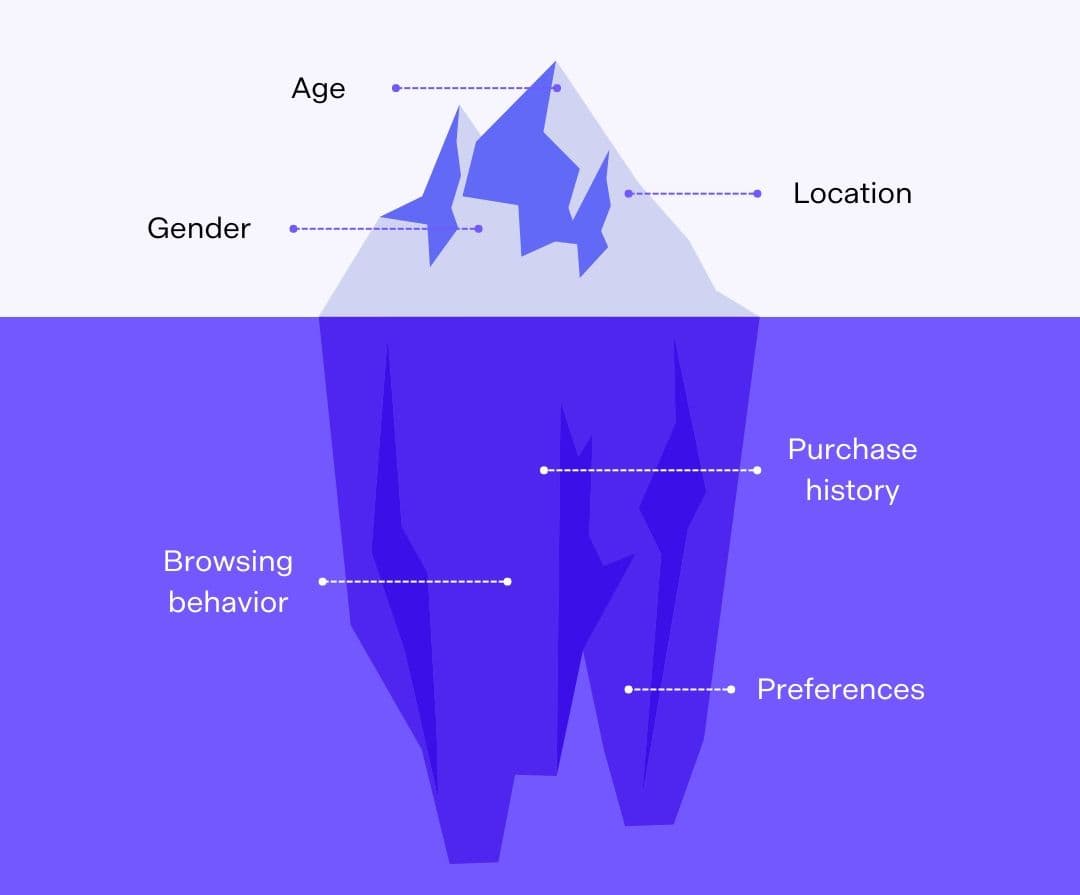

The uncanny valley of customer personalization
JUL. 29, 2024
2 Min Read
When done right, personalization cultivates a sense of loyalty that turns one-time buyers into brand advocates.
One-size-fits-all experiences don’t cut it anymore. Customers want (and increasingly expect) companies to ditch generic offerings and cater to their specific desires.
But at the same time, they don’t want their privacy violated. Organizations must find a way to walk this fine line without crossing into invasive territory.
The allure of customer personalization
Personalization reigns supreme in the realm of customer experience. There are few better ways to forge genuine connections with your target audience.
We’re not just talking about using someone’s first name in an email here — true personalization means understanding your customers’ unique preferences, anticipating their needs, and tailoring every touchpoint to resonate on a personal level.
When done right, personalization does more than just make customers feel seen and appreciated. It cultivates a sense of loyalty that turns one-time buyers into brand advocates.
Here are some time-tested ways to create a personalized customer experience.
Tailored content and personalized product recommendations
Picture this: A customer browses your ecommerce site looking for a new pair of running shoes. Instead of sifting through an endless catalog of generic options, they’re greeted with a selection curated just for them — shoes that match their running style, preferred terrain, and even their past purchases.
This is the power of personalized product recommendations and tailored content at work. The customer experience is elevated by surfacing the most pertinent information and offerings, saving your visitors time and effort.
Seamless user experiences
Showcasing the perfect product is just one aspect of customer journey personalization. Every touchpoint should be an effortless experience.
Let’s revisit the ecommerce example. Think about the last time you bought a shirt online. After locating the shirts menu, you probably had to manually filter for your size, color preference, and material.
Ideally, the retailer would streamline the path to purchase by pre-selecting those options based on your past purchases and preferences. Frictionless experiences like these are a great way to improve usability, reduce abandonment rates, and foster customer loyalty.
Rise of data-driven marketing
“An explosion of data is fueling modern marketing personalization,” says Mike Barkemeyer, Director of MarTech & Analytics Technologies at Lumenalta. “Companies have more customer information at their fingertips than ever before — the challenge is using it to create marketing campaigns that convert at higher rates.”
With this wealth of data, demographic segmentation is just the tip of the iceberg. Businesses can move beyond broad categories and create laser-focused segments based on nuanced behaviors, preferences, and purchase histories.
Marketers can use these precise segments to craft targeted campaigns that speak directly to the individual, delivering the right message at the right time through the right channel.

The dangers of over-personalization
While the benefits of personalization are undeniable, there’s a fine line between helpful and intrusive. Overstepping privacy boundaries can backfire, leading to several unintended consequences.
Filter bubbles and echo chambers
Barkemeyer explains that “personalized algorithms can inadvertently trap us in filter bubbles and echo chambers. When we’re constantly fed content that aligns with our existing beliefs, it’s easy to forget that there’s a whole world of diverse perspectives out there.”
What we think is the truth may just be a narrow slice of reality reinforced by algorithms designed to keep us engaged rather than informed. This phenomenon can have serious repercussions, ranging from individual biases to social polarization.
Invasive data collection practices
In pursuit of personalization, some companies have stepped into murky territory, amassing sensitive customer data without explicit consent. This overreach can quickly erode customer trust and trigger regulatory scrutiny.
The line between gathering valuable insights about your customers without invading their privacy can be blurry. When in doubt, err on the side of caution — violating customer data privacy can lead to reputational damage that’s hard to reverse.
Manipulation concerns
Marketing personalization should feel helpful and convenient, not manipulative. If a customer feels that you know a little too much about them, they might feel creeped out. Worse, they may question whether your suggestions are intended to be helpful or deceptively steer them toward a purchase.
This erosion of trust can have a ripple effect, harming your brand’s reputation and alienating customers who once felt valued. Stay well within data privacy compliance regulations and standards to keep your customers’ trust intact.
Loss of autonomy
The right personalization strategies can help users avoid decision fatigue by steering them toward options they’re likely to enjoy.
But they should always feel in control. As soon as a customer feels like they’ve been pigeonholed into a predetermined choice, your personalization efforts have backfired.
Overzealous personalization can make customers feel trapped, their choices dictated by past behaviors rather than their evolving interests. Along with limiting their ability to discover new products, this can stifle their sense of autonomy.
The concept of “privacy shaming”
Privacy shaming is an alarming trend that’s gaining traction online. It’s a manipulative tactic employed by some companies to coerce users into relinquishing their personal information for the promise of a personalized customer experience.
This often involves exploiting FOMO (fear of missing out) to nudge users towards sharing data they might otherwise prefer to keep private.
Dark patterns and coercive tactics
Privacy shaming often goes hand-in-hand with “dark patterns.” These are deceptive design tactics that exploit human psychology to steer users toward specific actions, often related to data sharing.
You’ve likely encountered them before: privacy settings buried deep within convoluted menus, confusing language that muddies the waters around data collection, or an opt-out process so frustrating it feels easier to just give in and share your data.
These tactics prey on our inherent desire for convenience, creating an illusion that sharing our data is the path of least resistance.
The long-term consequences of privacy shaming
“Firms that engage in privacy shaming are penny wise and pound foolish,” highlights Barkemeyer. “It might seem like a quick win in the personalization data race, but the long-term consequences almost always outweigh the benefits.”
Your customer trust that took years to build can be instantly shattered by this underhanded tactic. If that wasn’t bad enough, privacy shaming can trigger regulatory backlash, leading to fines, legal battles, and increased scrutiny.
The antidote to privacy shaming
The antidote to privacy shaming is simple: responsible data practices and transparent communication. Companies should be upfront about what data they collect, how it’s used, and why it benefits the customer.
Empower customers by giving them control over their privacy settings and offering straightforward opt-out options.
Even if you don’t collect as much customer data as a competitor, you’ll cultivate a trusting relationship that will pay dividends in the long run.
Finding the right balance
Advocating for a middle ground
Pushing the boundaries of data personalization isn’t necessary. Instead, allow your customers to lead the way — let them decide when they would like to share their data and when they’d rather keep it to themselves.
Customers that feel empowered and in control of their data, rather than exploited, are more likely to engage with your brand again and again.
Transparency in data collection and usage
“Customers are far more suspicious of shady data practices than they used to be,” Barkemeyer points out. “For that reason alone, transparency in your data practices is a must.”
Be upfront about your data governance practices: what data you collect, how it’s used, and who it’s shared with. And make sure privacy controls and opt-out options are easy to access.
A customer-centric approach
The race to collect more customer data than competitors is a futile one. In the long run, companies that prioritize customer trust will win out over those that collect as much data as possible.
Ethical personalization practices
The era of predatory data harvesting is coming to an end. Consumers and regulators alike have woken up to the drawbacks of these practices and are no longer tolerating them.
Fortunately, responsible personalization can benefit businesses and customers — it allows the former to cultivate long-lasting trust with their clients while giving the latter the transparency they’ve been looking for.
Striking this delicate balance isn’t always straightforward, so you need a trusted partner like Lumenalta to guide you through this complex landscape.
We can help you illuminate the boundaries between personalization and privacy, crafting strategies that resonate with your customers and remain in compliance with ever-changing legal and regulatory frameworks.



